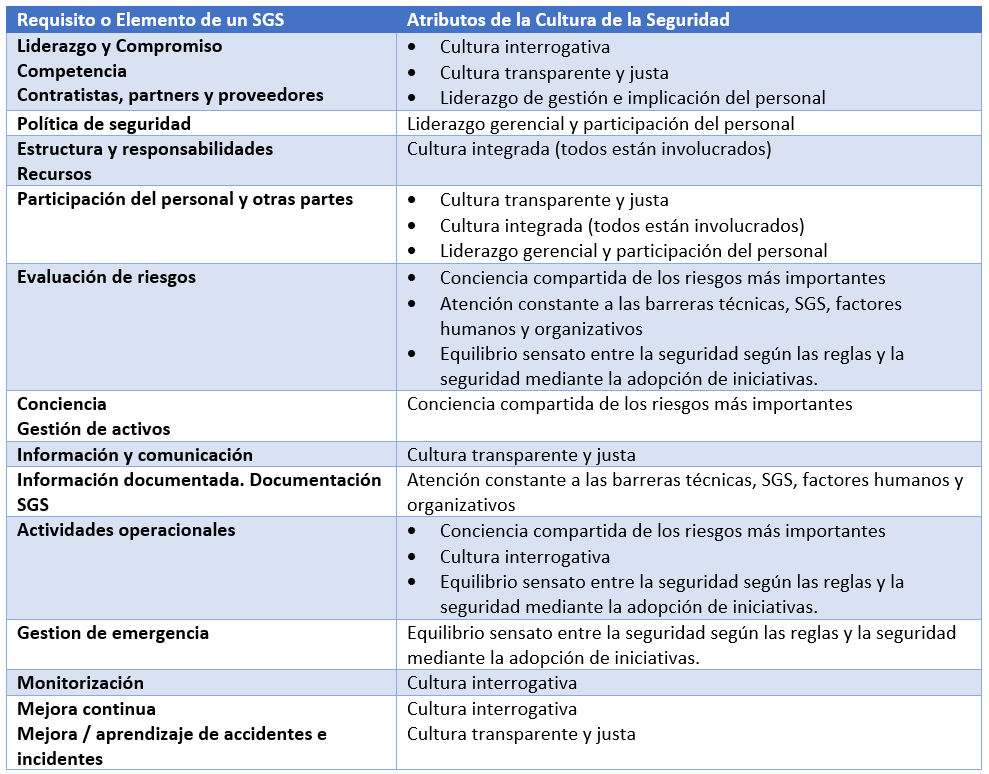The Safety Culture associated with a Safety Management System
The culture in
organizations arises from the interactions of people in their daily lives and
helps define the expectations and standards of
behavior it . The culture is a complex concept
that involves many factors, which develops over time depending on the
circumstances, the environment and experience of the organization.
The Safety Culture refers to the elements of culture that specifically address security. There is no single objective scientific measure of safety culture . This is because contributing factors vary, not only between organizations but also within them. Different departments have different security requirements and needs, for example operational and financial, and the prevailing Security Culture will develop from these. External factors such as regulatory requirements, education levels, social structures, and national culture will also contribute to an organization's safety culture.
The Culture of Safety is an established concept and used very commonly in sectors such as railways or aeronautics. However, it lacks a consensual definition. The lack of a definition has meant that theoretical discussion and practical applications often deviate from effective and useful channels for organizations.
That said, an easy way to describe Safety Culture is to look at the factors that contribute to people's behavior. The SGS ( Security Management System ) provides the basis defining and prescribing through policies and procedures what is required. In a utopia, the SGS would be perfect and all management and staff would deliver. Unfortunately, a utopia is a utopia, and what happens is that management and staff try to make sense of the content of the SMS based on their values, attitudes and beliefs derived from personal experience combined with the norms of workplace behavior. and society. If the SMS makes sense and there is a culture of compliance, the correct behaviors will be followed. If not, individual interpretations will be made and alternative solutions applied. These will be based on an individual risk assessment that weighs the factors that influence the decisions made . The risk assessment will not only focus on the real risk, but will also include factors related to convenience, the risk of being seen or not being seen by not following the regulatory channels, the words and actions of other people in the organization, etc. . The interdependence between the SMS, the creation of meaning and behavior, therefore, defines the Safety Culture.

Measuring Safety
Culture requires an understanding of the three factors and their
interdependence. As previously stated, there is no single objective
scientific measure of Safety Culture . Instead, the characteristics
that affect Safety Culture can be analyzed in light of the
three factors.
To understand the Safety Culture in an organization, specialists develop models, which generally involve the set of attributes of a positive Safety Culture . The following diagram presents, in summary form, the model used by Leedeo Engineering in terms of the implementation and continuous improvement of a positive Safety Culture associated with a Safety Management System .

Based on the previous model, we also designed a very powerful and interesting correlation between most of the elements of a Safety Management System (not all, but the vast majority) and the predominant attributes of a Safety Culture, as shown in the table below. This correlation between SGS and Safety Culture will be the starting point to develop the interdependence that we have previously discussed ( SGS, creation of meaning and behavior ):

We already have an SGS, why do we also need to ensure Safety Culture?
An SMS represents the competence of an organization in the area of security , and it is important to have an SMS and competent personnel to execute it. But such rules and processes may not always be followed, especially if people in the organization believe that, for example, "train punctuality" is the real top priority, even if risks are taken occasionally. To ensure the required commitment to safety , organizational leaders must demonstrate that safety is their priority.
Therefore, organizations need both an SMS and a healthy Safety Culture to achieve acceptable safety performance . Faced with this, there will always be strong resistance to change, moreover, from our experience in the railway industry: Generally, the railway is very safe, and accidents, both slight slas serious they occur only rarely. This means that almost all organizations will mistakenly assume that their systems, processes and performances are totally safe and under control, in addition to being totally inefficient (or useless) reactive improvement processes. Keep going based on incident experience.
Real rail accidents are often complex and multiple causes can be identified, so they are not always easy to predict. Even more difficult to see are the situations in the daily running of the organization that affect the "vision of the future" of an organization in terms of security. For example, underreporting of incidents due to fears of recrimination or prosecution; people who take risks because they think that is what they are supposed to do; different subgroups that do not share information due to lack of mutual trust; etc.
The Safety Culture should
be seen as a key business objective so that people with tasks
with associated risks feel empowered to act in the interests
of safety, knowing that the management will support
them. This improvement in mutual trust is always accompanied by a positive
impact on productivity.
At Leedeo Engineering , we are specialists in the implementation of models and processes to improve the security of organizations, including the Culture of Security . Do not hesitate to contact us for more information about our services. Contact >>
Are you interested in our articles about RAMS engineering and Technology?
Sign up for our newsletter and we will keep you informed of the publication of new articles.




